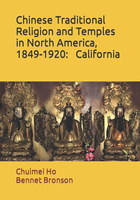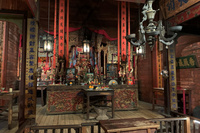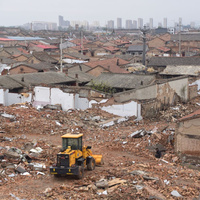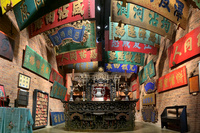Chinese Traditional Religion and Temples in North America, 1849–1920: California by Chuimei Ho and Bennet Bronson
Reviewed by Hannibal TaubesHannibal Taubes
PhD Candidate
University of California, Berkeley
Email the author: htaubes[at]berkeley.edu, twosmallblocks[at]gmail.com
Citation: Hannibal Taubes, book review of Chinese Traditional Religion and Temples in North America, 1849–1920: California by Chuimei Ho and Bennet Bronson, Nineteenth-Century Art Worldwide 22, no. 2 (Autumn 2023), https://doi.org/10.29411/ncaw.2023.22.2.15.
This work is licensed under a Creative Commons Attribution-NonCommercial 4.0 International License  unless otherwise noted.
unless otherwise noted.
Your browser will either open the file, download it to a folder, or display a dialog with options.

Chuimei Ho and Bennet Bronson,
Chinese Traditional Religion and Temples in North America, 1849–1920: California.
Seattle: Chinese in Northwest America Research Committee (CINARC), 2022.
523 pp.; 351 b&w illus.; notes; appendices; bibliography; index.
$29.99 (paperback)
ISBN: 9781723851469
Sometime between 1850 and the present, almost all the temples in China vanished (fig. 1). Scholar Susan Naquin counted 2,564 temples that existed within and immediately around the walls of the capital Beijing between 1403 and 1911; by her own estimation, this is probably an undercount of the actual number by as much as half. By the 1980s, perhaps several dozen still existed.[1] Surveying the Beijing hinterland in the 1940s (a landscape that seems to have survived unusually well for the period), Belgian missionary-scholar Willem Grootaers found that, depending on area, villages had an average of between three and 6.5 temples.[2] A small city of ca. 25,000 people had 294. Having spent several years in the 2010s surveying the same areas by satellite map, automobile, and on foot, it’s my own estimate that fewer than fifty of the 1,596 temple buildings Grootaers visited are now still physically standing. None survive intact with all the statues, altar goods, etc.[3] While it’s impossible to get before-and-after data on every last shrine in every last alley and grove, studies from across China suggest that the damage is general and massive, if fractally complex and uneven by area.[4] By the 1980s, even quite well-informed Western observers could wonder about the “disconcerting barrenness of the Chinese monumental landscape,” and doubt whether there could ever have been much there to begin with (fig. 2).[5]


We know roughly how this happened. The nineteenth and early twentieth centuries, which in France saw the pioneering restoration work of Eugène Viollet-le-Duc, and in Britain and the United States saw the first state-preserved historic sites, were in China an age of chaos, violence, and colonial immiseration. Two Opium Wars, the Taiping Rebellion, the Great Northwestern Rebellion, the Boxer Uprising, the Sino-Japanese wars, and the Chinese Civil War swept across the landscape in waves of devastation.[6] After the Hundred Days Reform of 1898, it became state policy to seize temple property and convert the buildings into schools or government offices. Within a few decades, many areas lost up to 75% of their temples this way.[7] Then the Communists took power. First came forced collectivization, then famine, and then the Great Cultural Revolution (1966–76), when gangs of teenage Red Guards ransacked whatever religious institutions remained and tormented the surviving clerics. Then Mao died and China opened up. The ensuing movement of people out of the villages and into the cities has been the largest migration in human history; those temples that still physically stood were bulldozed to build apartment complexes, or left to molder and collapse in half-abandoned villages.[8] Other areas have rebuilt their temples, sometimes in massive numbers, but from the preservationist standpoint this only compounds the destruction, since little care is taken to retain or record the original structures.[9] Attacks on religious institutions continue in 2023: under Xi Jinping, the Communist Party has led campaigns to bulldoze the centuries-old Sufi shrines of the Uyghurs, Turkic Muslims who live in China’s far west, as well as related campaigns against mosques and churches further east.[10]

The equivalent would be if Europe had, between roughly the nineteenth and the twenty-first centuries, simply demolished 95% of its churches, leaving no record of what almost any of those buildings had even looked like, let alone what statues, paintings, carvings, or religious texts had once been inside. For sheer scale, the destruction of China’s temples is surely one of the great events in human cultural history, as much part of the story of modernist aesthetics as steel-frame architecture or the impressionists (fig. 3).
One is therefore discomfited to learn that something very comparable happened in the United States of America. According to Ho and Bronson’s tabulations, between 1850 and 1920 there were over 230 Chinese temples in California alone, plus an unknown number more scattered across the North American continent. (In the parlance of the age, these were called joss- or josh-houses, from Portuguese deus.) San Francisco was a veritable holy city, with over sixty temples. Some counties in the Gold Rush hills had Chinese temples years before any Christian church was built, while yearly Chinese camp-meeting festivals in the mountains attracted thousands of worshippers, with Zhengyi-sect Daoist priests, great sacral processions, and deity-figures ten feet tall. By 1930 almost all of this had vanished. Today only a handful of temples can be said to remain intact: in the small towns of Marysville, Oroville, Weaverville, and Mendocino; a shrine in Hanford that was gutted by a fire in 2021; two temples in San Francisco, neither in their original locations; plus a handful more that have been rebuilt or survive only in part, or exist as small altars in historic Chinese business associations, etc.
Ho and Bronson propose causes for this sudden collapse: conversion to Christianity, white prejudice, progressivist politics, a lack of Chinese women. The great earthquake and fire of 1906 physically leveled the San Francisco Chinatown, “the heart of Chinese worship in the Western hemisphere” (2). The ruins were then comprehensively looted by white people, while the police looked on.[11] The Chinese Exclusion Acts began in 1882, and several generations thereafter were terrorized by abusive and corrupt immigration policy, mob violence, and economic and social segregation. Personal travel to and from the old country became almost impossible. As a result, between 1890 and 1920 the ethnically Chinese population of the United States dropped by almost half, from almost 107,000 to around 61,000.[12] The religion died.
Ho and Bronson’s book is therefore an elegy. Its effect is to overlay our Cowboys ’n’ Indians geography with another map, at once fully historical and tragically counterfactual, its ghostly river-routes and wagon-trails traced eastward up from the Pacific ports and to high plateaus and desert peaks: a lost Daoist America.
Ho and Bronson’s central approach is to read “temples as religious documents” (xi). Chinese temples in North America were (and are) both densely ornamented and densely textual spaces, with donation inscriptions on almost every individual object, decorative plaques with calligraphic mottos, publicly posted lists of donors and association members, regulations for worshippers, detailed account books, etc. Much of this epigraphy was photographed or survives in museums or private hands, collectively constituting “by far the largest body of secure evidence for the nature and practice of early Chinese religion in the United States” (xiii). Ho and Bronson combine this emic source base with deft research in town archives and local newspapers to build an overall portrait of the religion.
The book is divided into five sections. The first is entitled “Spiritual and Social Aspects of Temples.” Ho and Bronson introduce a typology of Chinese temples in the United States: public temples (miao) collectively managed by the Chinese communities, plus a variety of shrines associated with districts of origin associations (huiguan), charitable halls (shantang), clan associations (zongci), tradesmen’s guilds (hanghui), and “tongs” or secret societies (tang). Sections follow on the social functions of temples (individual and communal devotion, sites for managing funerals, venues for fortune-telling and spirit mediumship, plus community meeting places), and on the types of worship involved (yearly holidays, tachiu rituals [jiao], “bomb festivals” [paohui]), etc. There’s a useful section laying out the pantheon: “The 200+ temples and shrines that existed in California before 1900 housed a total of only 40 deities as represented by images and names on spirit tables. The great majority were Taoist” (42).
Section 2 treats “the physical side of temples” (83–151). This should be of great use to anyone trying to make sense of the rich physical culture of Chinese religion in the US, with sections on altarpieces, ritual standards, bells and drums, decorative plaques, parade lions and dragons, the unique and gorgeous “bright/colored gate” (caimen) carved hangings, etc. Inscriptions on the various pieces indicate that many were custom ordered from southern China, while others were made by local believers, or in workshops that sprang up in San Francisco and Portland. The section on architecture is particularly interesting: the authors note that, “Seen from the outside, the great majority of urban temples in North American Chinatowns were indistinguishable from the non-religious and non-Chinese buildings around them” (84). A few more Chinese-style structures existed in rural areas, but overall, “Very few Chinese religious buildings were close copies of homeland prototypes” (90). The authors also cast doubt on the idea that Chinese temples in California were generally sited according to fengshui principles. Fascinatingly, it was white urban planners who mandated the “oriental” architectural styles of the post-earthquake San Francisco Chinatown, in order to maintain the area as a tourist attraction.
There’s also a brief but engrossing section on “getting and displaying images of gods” (105–07). Some deity statues were shipped from China and received with great fanfare. Others were made from (in the words of one hostile white preacher) “the clay of the soil of this Christian land of ours” (106). This implies that consecration rituals were performed in the United States, i.e., that power-objects were placed inside the statues, that deities were ritually invited to reside there, and that their eyes were formally opened (kaiguang), thereby making these statues “living images” imbued with numinous force (ling).[13] Ho and Bronson conclude that such rituals probably did take place in the United States, but unfortunately there is almost no documentary evidence.
Sections 3 (“San Francisco”) and 4 (“Beyond San Francisco”) form a catalog of individual temples. The section on San Francisco is organized according to the type of institution, while the section on the rest of the state follows the geography of Chinese immigration: first Sierra Nevada mining towns in the 1850s to 1870s, then, when the mines failed or the Chinese were driven out by white violence, a move down to lowland agricultural centers in the 1880s and 1890s. Then come shorter sections on the coastal fishing communities and urban temples. Section 5 is a brief conclusion, which includes short but interesting essays on “Chinese American Religion in American Eyes” and “Chinese American Religion in Chinese Eyes.”

This gets to a central theme running through both the book and its documentary source base: the complex aesthetic, racial, and theological valuation of ornament, of color and intricacy, of gold gleaming in richly incensed dark (fig. 4). White Protestant observers wrote about these spaces in tones both jocular and queasy. Mark Twain (then a young reporter) described a San Francisco temple in 1864:
How would it strike you, now, to stand at one end of this room with ranks of repentant Chinamen extending down either side before you, sipping purifying tea, and all about and above them a gorgeous cloud of glaring colors and dazzling gold and tinsel, with the bell tolling, and the drums thundering, and the gongs clanging, and portly, blushing old Josh in the distance, smiling upon it all, in his imbecile way, from out his splendid canopy? Nice perhaps?
When Twain realizes the size and sophistication of this community of which he is a guest, this mix of racist condescension and sensorial wonder curdles into unease: “Ah Wae tells us that the Ning-Yong Company numbers eighteen or twenty thousand persons on this coast, now, and has numbered as high as twenty-eight thousand.”[14]
For others, Anglo-American and Chinese aesthetics were understood as akin to Protestant severity and Catholic splendor. An East Coast clergyman wrote,
When I entered this temple, my eyes became as it were, entranced with a blaze of glory! This sacred edifice if anything, excels all the other churches—even Rome in all her ancient gaudy apparel—in all her paraphernalia of rich gold mitres, and fine worked sacerdotals and decorated altars, cannot in my humble opinion, excel the rich tapestry and banners inlaid with gold and silver, the two altars inlaid and overlaid with gold and silver, surrounded with innumerable gold images representing the feast of Joss with his inferior satellites . . . ” (176).
A later writer was less sanguine, describing the same temple as, “a dingy-looking place, the gilded woodwork all tarnished, the embroideries grimy with dust and smoke.” These descriptions multiply, gyrating between awe and derision: “[the god’s] eyes sparkle with a glaring lustre” (166); “an exceedingly ugly little idol” (206); “[i]t is a fair specimen of Chinese wood sculpture but is entirely devoid of anything like spirituality” (165); “[t]he Josh House, we must admit, is attractively decorated and arranged and draws crowds of unbelievers. Just think of it! Twelve gods and two goddesses, made from the native soil of Weaverville Basin, decked in gorgeous array, and daubed all over with gold leaf and ornamented profusely with horse-hair . . . ” (296).
For the Chinese themselves, the visual splendor of these buildings had theological force. The ornamental plaques and couplets hung in the temples conceptualize the power of the gods in terms of effulgence or divine glory: “May the prosperous light shine a thousand leagues / may the auspicious air pervade mankind” (129); “[t]hy brilliance (guang) covers the four directions”; “[t]hy grace (ze, lit. ‘lustre’ or ‘waters’) embraces our people” (128) “upright and great, shining bright!”[15] Both violent racism and divine power are here tied up in a single aesthetic valuation, of the civilizational worth of ornament, and of the numinous power of light and color. The tremendum around these altars was dangerous; both sides felt it.
There are some problems with this book. The stated publisher is the “Chinese in Northwest America Research Committee,” an organization that consists of the authors and a handful of other researchers.[16] This is to say, it’s self-published, and it shows. There are some typos here and there, and all quotations are rendered in Comic Sans. The tables and pictures (which are many and interesting) are all in grayscale, which does serious injustice to the gorgeous colors of the objects and spaces in question. Some of the images are weirdly pixelated. There are also some slightly non-intuitive structural decisions: for some reason there are two notes sections, one halfway through the book, and one at the end. The decision to order the temples by economic-geographical region makes sense in terms of the authors’ historical analysis, but it does mean that anyone trying to look up information about a particular temple will need a good historical map of California in their head and a bit of guesswork (e.g., it turns out that San Diego is a “coastal center” not an “urban center”). All this is extremely minor and in no way affects the usability of the book.
Some slightly more substantive issues: given how difficult it is to hear the voices of historical Chinese people in the Americas, not to mention how few Americanists read classical Chinese, it’s a little disappointing that the authors don’t transcribe and translate more of the temple inscriptions. It’s also worth pointing out for those outside the field of Chinese studies that the terms “Daoism” and “Daoists” have complicated modern histories.[17] Contemporary scholars apply these words carefully, especially when describing the ascriptive identities of laypeople. Ho and Bronson are adamant that Chinese-Americans “were real Taoists” (39). Are there documents in which Chinese-Americans prior to 1920 identify themselves as “Daoists”?
These are minor gripes. Ho and Bronson’s tome will now be the standard reference work on this subject and should be on the shelf of everyone interested in Chinese art and religion, Asian-American studies, immigrant visual cultures in the Americas, and California generally. The authors note that they are considering a follow-up volume that will treat Chinese temples in North America outside of California. Let us hope that this work is completed and that the two volumes can be published together under the imprint of a major press, with color photographs and a few editorial tweaks, as befits this important scholarship.
Notes
[1] Susan Naquin, Peking: Temples and City Life, 1400–1900 (Berkeley and Los Angeles: University of California Press, 2007), 707, 709–10.
[2] Willem Grootaers, “Les Temples Villageois de la Région au Sud Est de Tat’ong (Chansi Nord), Leurs Inscriptions et Leur Histoire (The Village Temples of the Region South East of Tat'ong [Northern Chansi], Their Inscriptions and Their History),” Folklore Studies, no. 4 (1945): 186; Willem Grootaers, “Temples and History of Wanch’uan 萬全 (Chahar): The Geographical Method Applied to History,” Monumenta Serica, no. 13 (1948): 216.
[3] See the data in Willem Grootaers, Li Shih-yü (李世瑜), and Wang Fu-shih (王輔世), The Sanctuaries in a North-China City: A Complete Survey of the Cultic Buildings in the City of Hsüan-hua (Chahar), Mélanges Chinois et Bouddhiques (Chinese and Buddhist Melanges), vol. XXVI (Brussels: Institut Belge des Hautes Études Chinoises, 1995), 118–21. The number 1,596 is an aggregate of 349 temples in Datong county, 592 temples in Wanquan county, 361 temples in Xuanhua county, and 294 temples in Xuanhua city.
[4] For more estimates of losses of temples in various regions, see the specific citations below. The complex politics of memory around the destruction of even a single temple are examined in Jing Jun, The Temple of Memories: History, Power, and Morality in a Chinese Village (Stanford: Stanford University Press, 1996).
[5] Pierre Ryckmans, “The Chinese Attitude Towards the Past,” China Heritage Quarterly, no. 14 (June 2008), http://www.chinaheritagequarterly.org/. Originally published as “The Chinese Attitude Towards the Past,” in The Forty-seventh George Ernest Morrison Lecture in Ethnology, 1986 (Canberra: The Australian National University, 1986).
[6] For a study of temple destruction caused by the Taiping rebellion, see Gregory Adam Scott, Building the Buddhist Revival: Reconstructing Monasteries in Modern China (Oxford and New York: Oxford University Press, 2020), 43–53.
[7] A recent discussion of this, with footnotes for further scholarship, is found at Paul R. Katz and Vincent Goossaert, The Fifty Years that Changed Chinese Religion, 1898–1948 (Ann Arbor: Association for Asian Studies, 2021), 23–35. The 75% statistic refers to Ding County; see Vincent Goossaert and David A. Palmer, The Religious Question in Modern China (Chicago and London: The University of Chicago Press, 2011), 126.
[8] A useful recent overview of this mass urbanization is Kam Wing Chan with Fang Cai and Man Wang, Urbanization with Chinese Characteristics: The Hukou System and Migration (London and New York: Routledge, 2018). A case study of temples in the face of one Chinese city’s post-Mao urban expansion can be found at Vincent Goossaert, “Territorial Cults and the Urbanization of the Chinese World: A Case Study of Suzhou,” in Handbook of Religion and the Asian City: Aspiration and Urbanization in the Twenty-First Century, ed. Peter van der Veer (Oakland: University of California Press, 2015), 52–68.
[9] Even areas that appear to have rebuilt their temples en masse still experienced massive losses compared to pre-Communist numbers. See Adam Yuet Chau, Miraculous Response: Doing Popular Religion in Contemporary China (Stanford: Stanford University Press, 2006), 45–51; Kenneth Dean and Zheng Zhenman, Ritual Alliances of the Putian Plain, vol. 1, Historical Introduction to the Return of the Gods (Leiden and Boston: Brill, 2010), 143–50. In other areas (for instance Grootaers’s and my own survey-regions), only a tiny fraction of the original temples have been built back.
[10] Rian Thum, “The Spatial Cleansing of Xinjiang: Mazar Desecration in Context,” Made in China 5, no. 2 (May-August 2020), https://madeinchinajournal.com/. For campaigns of mosque demolition aimed at Chinese Muslim (Hui) communities in the contemporary period, see Hannah Theaker and David Stroup, Making Islam Chinese: Religious Policy and Mosque Sinicization in the Xi Era (Sheffield: University of Sheffield, forthcoming, 2023).
[11] Iris Chang, The Chinese in America: A Narrative History, (New York: Viking, 2003), 145–46.
[12] Campbell Gibson and Kay Jung, Population Division Working Paper No. 45, “Historical Census Statistics on Population Totals by Race, 1790 to 1990, and by Hispanic Origin, 1970 to 1990, for the United States, Regions, Divisions, and States,” United States Census Bureau, September 13, 2002, Appendix C9–11, PDF 144–6, https://www.census.gov/.
[13] For studies of this sort of empowered deity-image, see Lin Wei-ping, Materializing Magic Power: Chinese Popular Religion in Villages and Cities (Cambridge, MA and London: Harvard University Asia Center, 2015); Alain Arrault, A History of Cultic Images in China: The Domestic Statuary of Hunan, trans. Lina Verchery (Hong Kong: The Chinese University of Hong Kong Press, 2020).
[14] Partially quoted in Ho and Bronson, Chinese Traditional Religion, 172. Full quotation in Mark Twain, “The New Chinese Temple,” Early Tales and Sketches, vol. 2, ed. Robert Hirst and Harriet Elinor Smith (Berkeley, Los Angeles, and London: University of California Press, 1981), 41–42.
[15] Translation by author; Ho and Bronson translate zheng da guang ming (正大光明) as “[Thou Art] Just and Righteous” (127). This phrase is a quote from the Confucian philosopher Zhu Xi, which famously hangs above the throne in the Qianqing Palace of the Forbidden City.
[16] “About Us and Contacting Us,” Chinese in Northwest America Research Committee (CINARC 金山西北角 - 華裔研究中心), https://www.cinarc.org/.
[17] A useful introduction to Chinese religious identities in modernity is found in Goossaert and Palmer, The Religious Question in Modern China, 1–90; a relevant discussion of Daoism versus Chinese popular religion more generally is found in Paul Katz, “Taoism and Local Cults,” in The Encyclopedia of Taoism, vol. 1, ed. Fabrizio Pregadio (London and New York: Routledge, 2008), 152–56.